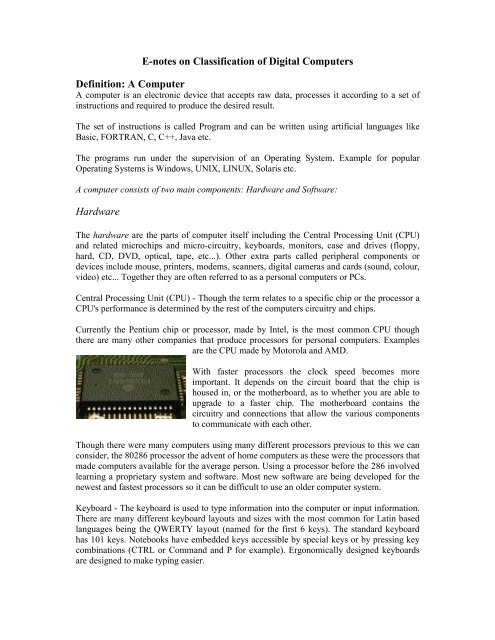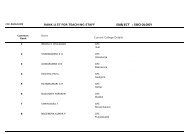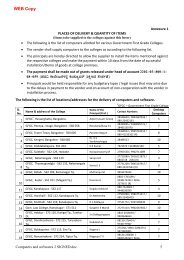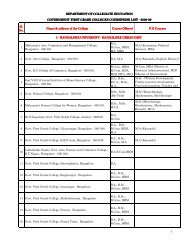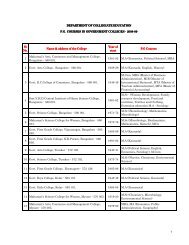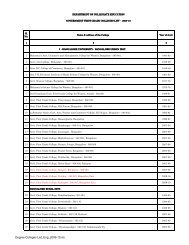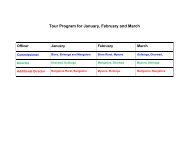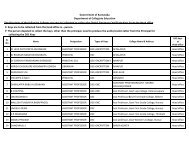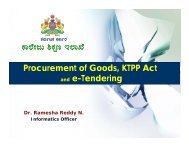Session 2 Classification Of digital Computers - Department of ...
Session 2 Classification Of digital Computers - Department of ...
Session 2 Classification Of digital Computers - Department of ...
Create successful ePaper yourself
Turn your PDF publications into a flip-book with our unique Google optimized e-Paper software.
E-notes on <strong>Classification</strong> <strong>of</strong> Digital <strong>Computers</strong><br />
Definition: A Computer<br />
A computer is an electronic device that accepts raw data, processes it according to a set <strong>of</strong><br />
instructions and required to produce the desired result.<br />
The set <strong>of</strong> instructions is called Program and can be written using artificial languages like<br />
Basic, FORTRAN, C, C++, Java etc.<br />
The programs run under the supervision <strong>of</strong> an Operating System. Example for popular<br />
Operating Systems is Windows, UNIX, LINUX, Solaris etc.<br />
A computer consists <strong>of</strong> two main components: Hardware and S<strong>of</strong>tware:<br />
Hardware<br />
The hardware are the parts <strong>of</strong> computer itself including the Central Processing Unit (CPU)<br />
and related microchips and micro-circuitry, keyboards, monitors, case and drives (floppy,<br />
hard, CD, DVD, optical, tape, etc...). Other extra parts called peripheral components or<br />
devices include mouse, printers, modems, scanners, <strong>digital</strong> cameras and cards (sound, colour,<br />
video) etc... Together they are <strong>of</strong>ten referred to as a personal computers or PCs.<br />
Central Processing Unit (CPU) - Though the term relates to a specific chip or the processor a<br />
CPU's performance is determined by the rest <strong>of</strong> the computers circuitry and chips.<br />
Currently the Pentium chip or processor, made by Intel, is the most common CPU though<br />
there are many other companies that produce processors for personal computers. Examples<br />
are the CPU made by Motorola and AMD.<br />
With faster processors the clock speed becomes more<br />
important. It depends on the circuit board that the chip is<br />
housed in, or the motherboard, as to whether you are able to<br />
upgrade to a faster chip. The motherboard contains the<br />
circuitry and connections that allow the various components<br />
to communicate with each other.<br />
Though there were many computers using many different processors previous to this we can<br />
consider, the 80286 processor the advent <strong>of</strong> home computers as these were the processors that<br />
made computers available for the average person. Using a processor before the 286 involved<br />
learning a proprietary system and s<strong>of</strong>tware. Most new s<strong>of</strong>tware are being developed for the<br />
newest and fastest processors so it can be difficult to use an older computer system.<br />
Keyboard - The keyboard is used to type information into the computer or input information.<br />
There are many different keyboard layouts and sizes with the most common for Latin based<br />
languages being the QWERTY layout (named for the first 6 keys). The standard keyboard<br />
has 101 keys. Notebooks have embedded keys accessible by special keys or by pressing key<br />
combinations (CTRL or Command and P for example). Ergonomically designed keyboards<br />
are designed to make typing easier.
Some <strong>of</strong> the keys have a special use. There are referred to as command keys. The 3 most<br />
common are the Control or CTRL, Alternate or Alt and the Shift keys though there can be<br />
more (the Windows key for example or the Command key). Each key on a standard keyboard<br />
has one or two characters. Press the key to get the lower character and hold Shift to get the<br />
upper.<br />
Disk Drives - All disks need a drive to get information <strong>of</strong>f - or read - and put information on<br />
the disk - or write. Each drive is designed for a specific type <strong>of</strong> disk whether it is a CD, DVD,<br />
hard disk or floppy. <strong>Of</strong>ten the term 'disk' and 'drive' are used to describe the same thing but it<br />
helps to understand that the disk is the storage device which contains computer files - or<br />
s<strong>of</strong>tware - and the drive is the mechanism that runs the disk.<br />
mouse.<br />
Mouse - Most modern computers today are run using a mouse controlled<br />
pointer. Generally if the mouse has two buttons the left one is used to select<br />
objects and text and the right one is used to access menus. If the mouse has<br />
one button (Mac for instance) it controls all the activity and a mouse with a<br />
third buttons can be used by specific s<strong>of</strong>tware programs.<br />
One type <strong>of</strong> mouse has a round ball under the bottom <strong>of</strong> the mouse that rolls<br />
and turns two wheels which control the direction <strong>of</strong> the pointer on the screen.<br />
Another type <strong>of</strong> mouse uses an optical system to track the movement <strong>of</strong> the<br />
Monitors - The monitor shows information on the screen when you type. This is called<br />
outputting information. When the computer needs more information it will display a message<br />
on the screen, usually through a dialog box. Monitors come in many types and sizes from the<br />
simple monochrome (one color) screen to full color screens.<br />
Most desktop computers use a monitor with a cathode tube and most notebooks use a liquid<br />
crystal display (LCD) monitor.<br />
To get the full benefit <strong>of</strong> today's s<strong>of</strong>tware with full color graphics and animation, computers<br />
need a color monitor with a display or graphics card.<br />
Printers - The printer takes the information on your screen and transfers it to paper or a hard<br />
copy. There are many different types <strong>of</strong> printers with various levels <strong>of</strong> quality. The three<br />
basic types <strong>of</strong> printer are; dot matrix, inkjet, and laser.<br />
Dot matrix printers work like a typewriter transferring ink from a ribbon to paper with a<br />
series or 'matrix' <strong>of</strong> tiny pins.<br />
Ink jet printers work like dot matrix printers but fire a stream <strong>of</strong> ink from a cartridge directly<br />
onto the paper.<br />
Laser printers use the same technology as a photocopier using heat to transfer toner onto<br />
paper.<br />
Modem - A modem is used to translate information transferred through telephone lines or<br />
cable. The term stands for modulate and demodulate which changes the signal from <strong>digital</strong>,<br />
which computers use, to analog, which telephones use and then back again. A high speed<br />
connection also requires a modem but because the information is transferred <strong>digital</strong>ly it isn't<br />
required to change the signal from <strong>digital</strong> to analog but is used to create the connection<br />
between your computer and the computer you are connecting with.<br />
Modems are measured by the speed that the information is transferred. The measuring tool is<br />
called the baud rate. Originally modems worked at speeds below 2400 baud but today analog<br />
speeds <strong>of</strong> 56,000 are common. Cable, wireless or <strong>digital</strong> subscriber lines (DSL) modems can<br />
transfer information much faster with rates <strong>of</strong> 300,000 baud and up.
Modems also use Error Correction which corrects for transmission errors by constantly<br />
checking whether the information was received properly or not and Compression which<br />
allows for faster data transfer rates. Information is transferred in packets. Each packet is<br />
checked for errors and is re-sent if there is an error.<br />
Anyone who has used the Internet has noticed that at times the information travels at different<br />
speeds. Depending on the amount <strong>of</strong> information that is being transferred the information will<br />
arrive it's destination at different times. The amount <strong>of</strong> information that can travel through a<br />
line is limited. This limit is called bandwidth.<br />
Scanners- Scanners allow you to transfer pictures and photographs to your computer. A<br />
scanner 'scans' the image from the top to the bottom, one line at a time and transfers it to the<br />
computer as a series <strong>of</strong> bits or a bitmap. You can then take that image and use it in a paint<br />
program, send it out as a fax or print it. With optional Optical Character Recognition (OCR)<br />
s<strong>of</strong>tware you can convert printed documents such as newspaper articles to text that can be<br />
used in your word processor. Most scanners use TWAIN s<strong>of</strong>tware that makes the scanner<br />
accessible by other s<strong>of</strong>tware applications.<br />
Digital cameras allow you to take <strong>digital</strong> photographs. The images are stored on a memory<br />
chip or disk that can be transferred to your computer. Some cameras can also capture sound<br />
and video.<br />
Case - The case houses the microchips and circuitry that run the computer. Desktop models<br />
usually sit under the monitor and tower models beside. They come in many sizes, including<br />
desktop, mini, midi, and full tower. There is usually room inside to expand or add<br />
components at a later time. By removing the cover <strong>of</strong>f the case you may find plate covered<br />
empty slots that allow you to add cards. There are various types <strong>of</strong> slots including IDE, ASI,<br />
USB, PCI slots.<br />
Notebook computers may have room to expand depending on the type <strong>of</strong> computer. Most<br />
Notebooks also have connections or ports that allow expansion or connection to exterior,<br />
peripheral devices such as monitor, portable hard-drives or other devices.<br />
Cards - Cards are components added to computers to increase their capability. When adding a<br />
peripheral device makes sure that your computer has a slot <strong>of</strong> the type needed by the device.<br />
Sound cards allow computers to produce sound like music and voice. The older sound cards<br />
were 8 bit then 16 bit then 32 bit. Though human ear can't distinguish the fine difference<br />
between sounds produced by the more powerful sound card they allow for more complex<br />
music and music production.<br />
Color cards allow computers to produce color (with a colour monitor <strong>of</strong> course). The first<br />
color cards were 2 bit which produced 4 colors [CGA]. It was amazing what could be done<br />
with those 4 colors. Next came 4 bit allowing for 16 [EGA and VGA ] colors Then came 16<br />
bit allowing for 1064 colors and then 24 bit which allows for almost 17 million colors and<br />
now 32 bit is standard allowing monitors to display almost a billion separate colors.<br />
Video cards allow computers to display video and animation. Some video cards allow<br />
computers to display television as well as capture frames from video. A video card with a<br />
<strong>digital</strong> video camera allows computers users to produce live video. A high speed or network<br />
connection is needed for effective video transmission.<br />
Network cards allow computers to connect together to communicate with each other.<br />
Network cards have connections for cable, thin wire or wireless networks.
Cables connect internal components to the Motherboard, which is a board with series <strong>of</strong><br />
electronic path ways and connections allowing the CPU to communicate with the other<br />
components <strong>of</strong> the computer.<br />
Memory - Memory can be very confusing but is usually one <strong>of</strong> the easiest pieces <strong>of</strong> hardware<br />
to add to your computer. It is common to confuse chip memory with disk storage. An<br />
example <strong>of</strong> the difference between memory and storage would be the difference between a<br />
table where the actual work is done (memory) and a filing cabinet where the finished product<br />
is stored (disk). To add a bit more confusion, the computer's hard disk can be used as<br />
temporary memory when the program needs more than the chips can provide.<br />
Random Access Memory or RAM is the memory that the computer uses to temporarily store<br />
the information as it is being processed. The more information being processed the more<br />
RAM the computer needs.<br />
One <strong>of</strong> the first home computers used 64 kilobytes <strong>of</strong> RAM memory (Commodore 64).<br />
Today's modern computers need a minimum <strong>of</strong> 64 MB (recommended 128 MB or more) to<br />
run Windows with modern s<strong>of</strong>tware.<br />
RAM memory chips come in many different sizes and speeds and can usually be expanded.<br />
Older computers came with 512 KB <strong>of</strong> memory which could be expanded to a maximum <strong>of</strong><br />
640 KB. In most modern computers the memory can be expand by adding or replacing the<br />
memory chips depending on the processor you have and the type <strong>of</strong> memory your computer<br />
uses. Memory chips range in size from 1 MB to 512 MB. As computer technology changes<br />
the type <strong>of</strong> memory changes as well making old memory chips obsolete. Check your<br />
computer manual to find out what kind <strong>of</strong> memory your computer uses before purchasing<br />
new memory chips.<br />
S<strong>of</strong>tware<br />
The s<strong>of</strong>tware is the information that the computer uses to get the job done. S<strong>of</strong>tware needs to<br />
be accessed before it can be used. There are many terms used for process <strong>of</strong> accessing<br />
s<strong>of</strong>tware including running, executing, starting up, opening, and others.<br />
Computer programs allow users to complete tasks. A program can also be referred to as an<br />
application and the two words are used interchangeably.<br />
Examples <strong>of</strong> s<strong>of</strong>tware programs or applications would be the Operating System (DOS,<br />
Windows 9x/Millenium/XP, O/S2, UNIX, MacOS 9.x/10.x and various others),<br />
Wordprocessor (typing letters), Spreadsheet (financial info), Database (inventory control and<br />
address book), Graphics program, Internet Browser, Email and many others.<br />
As well any document that you create, graphic you design, sound you compose, file you<br />
make, letter you write, email you send or anything that you create on your computer is<br />
referred to as s<strong>of</strong>tware. All s<strong>of</strong>tware is stored in files.<br />
S<strong>of</strong>tware is stored on a disk or tape whether that disk is a floppy, hard Disk, CD, tape or one<br />
<strong>of</strong> the dozens <strong>of</strong> other storage devices available.<br />
<strong>Classification</strong> <strong>of</strong> Digital <strong>Computers</strong><br />
In general, computers can be classified based upon their mode <strong>of</strong> use as
1) Computer for simple use<br />
2) <strong>Computers</strong> for Organizational Use<br />
Simple computers are also called Micro <strong>Computers</strong> and include Personal <strong>Computers</strong>,<br />
Laptops, PDA (Personal Digital Assistant), Workstations etc.<br />
Some computers will have high configuration. We may not able to get full benefit <strong>of</strong> what we<br />
spent on those computers by using alone. So, they are preferred for organizational use and<br />
examples include servers, Mainframes, mini computers and Super computers.<br />
Let us discuss them one by one:<br />
Personal <strong>Computers</strong>: Popularly called PCs.<br />
They are found almost every where<br />
nowadays. They cost less and are suitable for<br />
house and individual use. They comprise <strong>of</strong><br />
a monitor, a keyboard, CPU with floppy, CD<br />
and Hard disks and a mouse at the simplest.<br />
We can enhance the components in terms <strong>of</strong><br />
numbers as well as configurations based<br />
upon needs.<br />
They run s<strong>of</strong>tware like word processors,<br />
excel, compilers, image viewers, games,<br />
Internet besides the operating system.<br />
They are used basically for simple task such<br />
as documentation, writing simple programs,<br />
to watch movies, listen to the music, to<br />
browse Internet to check emails, to<br />
download material from web sites etc.<br />
Laptops:<br />
They are equivalent to PCs in their<br />
functionality. But, very small in size<br />
compared to PCs. They are portable, in the<br />
sense,<br />
you can carry them wherever you travel. They run on<br />
battery. As long as the battery can supply<br />
power,<br />
the laptops function. Here, monitor, keyboard,<br />
Mouse,<br />
storage devices are integrated as one device<br />
and get a<br />
common power supply.<br />
Advantage is, they are portable and handy.<br />
Basic<br />
disadvantages are, they are costly and theft<br />
prone. If<br />
you want to upgrade the existing configuration<br />
they<br />
proved to be still costlier.<br />
Personal Digital Assistant (PDA)<br />
They are small computers which can be held in hands. They are used<br />
to browse Internet and receive/send short messages. They are also used<br />
to store information which can then be transferred to PCs in leisure.<br />
Nowadays they are used to work with smart cards which have user<br />
information like Name, their loan or crop details. When the person
comes from a particular department, he will have PDA with him. The farmers can just swipe<br />
the card and do necessary transaction.<br />
They are good basically for information transfer rather than information processing.<br />
Workstations:<br />
They are high end PCs. They contain more memory and high speed processor compared to<br />
PCs. They host s<strong>of</strong>tware requiring more resource. They are used in business but by a single<br />
user. Typical work done on workstations includes vide editing, animation, drafting <strong>of</strong> an<br />
architectural design, animation etc.<br />
<strong>Computers</strong> for Organizational use:<br />
Servers:<br />
They are super fast, high configured computers intended to serve the node in a network.<br />
Nodes in turn are PCs. They are connected to server which hosts all or most <strong>of</strong> the s<strong>of</strong>tware<br />
required by them. They run only one copy <strong>of</strong> the s<strong>of</strong>tware installed on the server. Hence,<br />
Servers should be very fast.<br />
They serve all nodes and bit costlier compared to simple<br />
PCs.<br />
<strong>Computers</strong> communicate with each other through<br />
underlying framework called Network. A network can be as<br />
simple as connecting two PCs together to a Local Area<br />
Networm popularly called LAN to MAN, the Metropolitan<br />
Area Network to WWW, the popular World Wide Web.<br />
Mainframe computers:<br />
Mainframes are computers used mainly by large<br />
organizations for critical applications, typically bulk<br />
data processing such as census, industry and consumer<br />
statistics, ERP, and financial transaction processing.<br />
packages.<br />
The term probably originated from the early<br />
mainframes, as they were housed in enormous, roomsized<br />
metal boxes or frames. Later the term was used to<br />
distinguish high-end commercial machines from less<br />
powerful units which were <strong>of</strong>ten contained in smaller
Today in practice, the term usually refers to computers compatible with the IBM System/360<br />
line, first introduced in 1965. Otherwise, systems with similar functionality but not based on<br />
the IBM System/360 are referred to as "servers." However, "server" and "mainframe" are not<br />
synonymous.<br />
Minicomputers:<br />
Minicomputers fall in the range between Mainframes and Microcomputers. They are used by<br />
small and mid-size industries.<br />
There were several minicomputer operating systems and architectures that arose in the 1970s<br />
and 1980s, but minicomputers are generally not considered mainframes. (UNIX arose as a<br />
minicomputer operating system; Unix has scaled up over the years to acquire some<br />
mainframe characteristics).<br />
Super computers:<br />
They are the powerful computers available till<br />
today. A supercomputer is a computer that led<br />
the world (or was close to doing so) in terms <strong>of</strong><br />
processing capacity, particularly speed <strong>of</strong><br />
calculation, at the time <strong>of</strong> its introduction.<br />
Today, they have the capacity to do huge<br />
processing <strong>of</strong> data including scientific and<br />
military applications. They are the one which<br />
enable news channels around the world to bring<br />
you up-to-date weather information. The amount<br />
<strong>of</strong> processing goes behind this work is enormous<br />
and only super computers can do it.<br />
Applications <strong>of</strong> <strong>Computers</strong>:<br />
<strong>Computers</strong> are used everywhere. They found their application starting with playing games till<br />
processing satellite images to give weather information.<br />
At Home:<br />
They are used mostly to check mails or chat with family members abroad. You can do video<br />
enabled chatting where you actually can see the person you are talking to. Other applications<br />
include gaming, listening to music, watching movies and to do some small documentation<br />
task. Students use computers to complete the homework given at school or college.<br />
In Education:<br />
Computer education is becoming mandatory in most <strong>of</strong> the universities across the world.<br />
They basically teach the subjects which enable the students to acquire a job in s<strong>of</strong>tware
engineering Industry. Teachers use computers as teaching aids which leaves some time for<br />
the discussion at the end <strong>of</strong> session. Nowadays colleges are setting up such a system where<br />
student and faculty attendance, syllabus, scheduled <strong>of</strong> tests, exams etc are put on the web and<br />
students, their parents and faculties can access it from anywhere and get updated.<br />
In Industries<br />
Mostly the s<strong>of</strong>tware or the hardware that are produced by companies would be used to<br />
automate the manual task. One kind <strong>of</strong> industry will have the task <strong>of</strong> producing such products<br />
and is called s<strong>of</strong>tware industry. Other companies which use these services are called clients.<br />
<strong>Computers</strong> can be used to produce pattern in textile industries, colors combinations in paint<br />
industries, automate the operation <strong>of</strong> a machine in an industry using robotics etc.<br />
In Business:<br />
They are used in commercial organization for clerical and administrative purposes. Tax<br />
calculations, salary slip preparations etc. can be done using computers. Stock market<br />
predictions can be done. Banks are using computers to maintain the account details and<br />
transactions. E-banking is picking up popularity because <strong>of</strong> the flexibility <strong>of</strong> banking sitting<br />
at a terminal anywhere. Excluding the matter <strong>of</strong> much talked security, they are used<br />
comfortably by the customers. E – Shopping is one more concept gaining popularity in<br />
industry where a customer can buy the displayed items by paying using credit card or cash on<br />
delivery options.<br />
In Entertainment:<br />
Animations and Special Effects for the movies are done using high end workstations. In<br />
Titanic movie they used 100 high end Linux workstations in parallel to produce the special<br />
effects. Also, the movies and music are available in the form <strong>of</strong> CDs, VCDs, and DVDs<br />
which cost less compared to watching movies at theatres. People prefer to watch them<br />
through these media in their leisure time. Kids enjoy playing games using computers.<br />
By Government<br />
A Government use computers at their <strong>of</strong>fices to keep track <strong>of</strong> attendance <strong>of</strong> an employee at<br />
the simplest to military applications, satellite launching, collecting taxes. They are used<br />
almost in every public sector for one or the other task from schools to teach necessary skills<br />
to police stations to record complaints for example.


